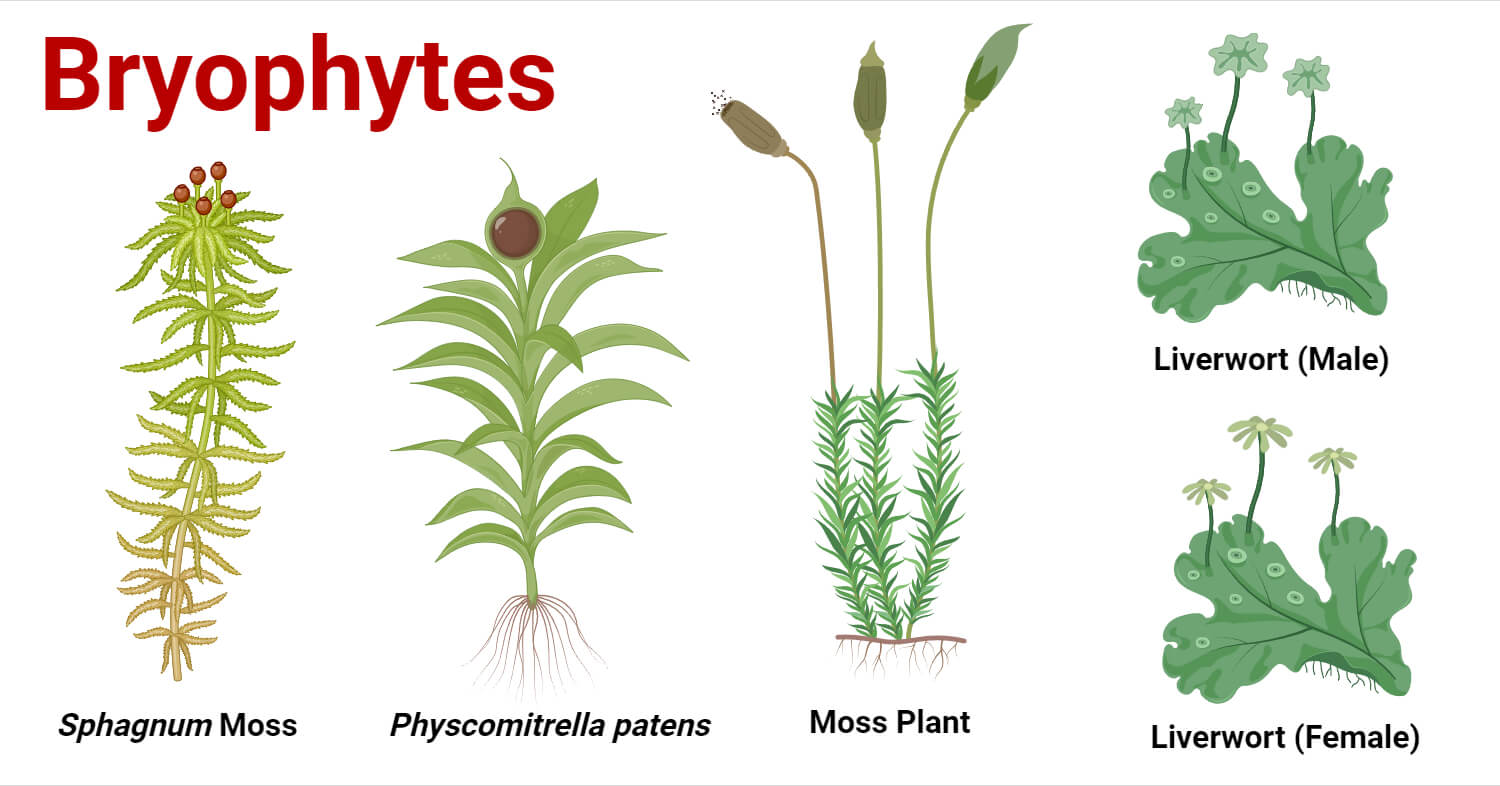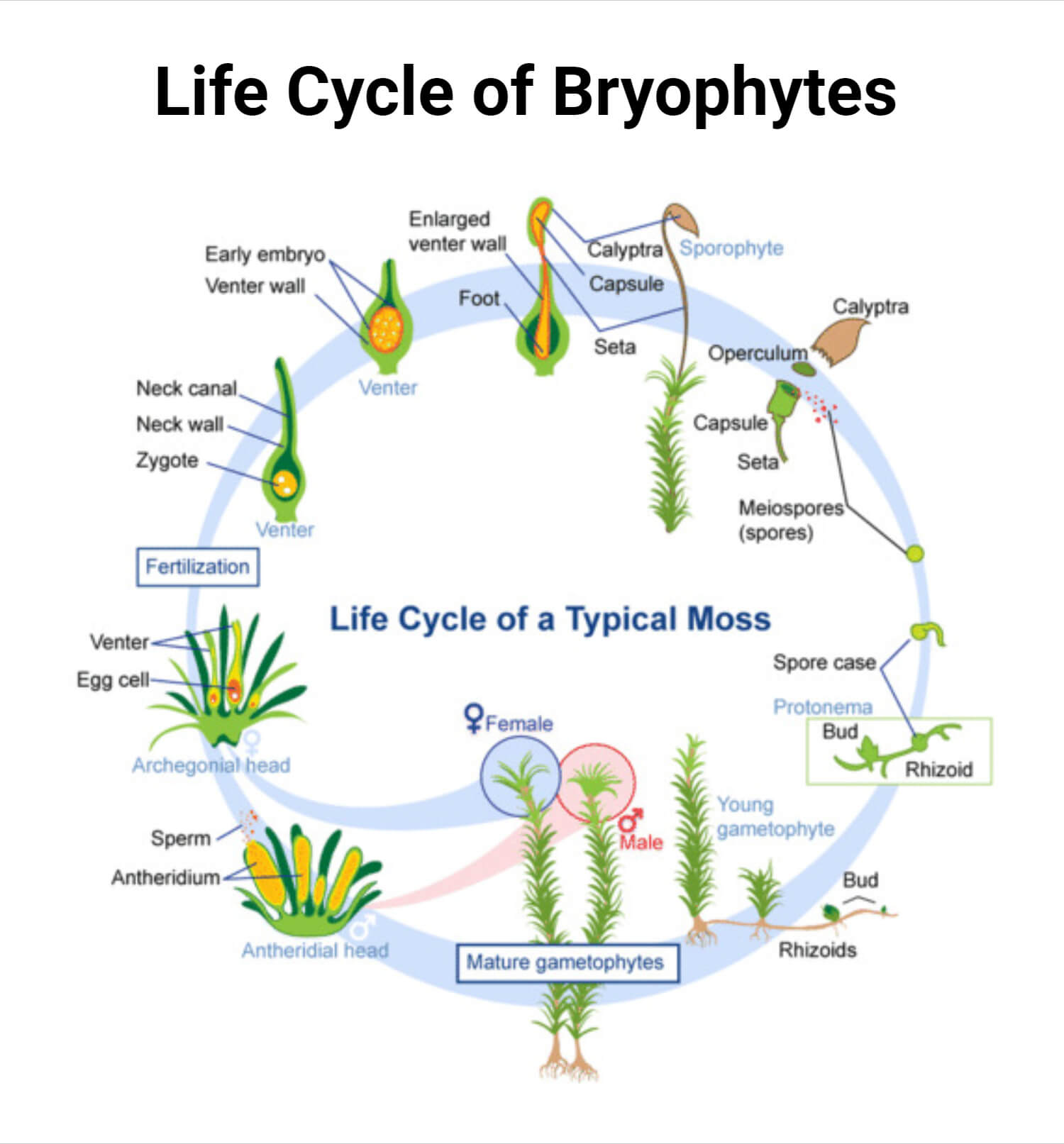Bryophytes are a group of non-vascular, non-flowering, seedless land plants which are also known as “Amphibians of Plant Kingdom.” They include liverworts, mosses, and hornworts. There are almost 20,000 species of bryophytes present all over the world.

Interesting Science Videos
General Characteristics of Bryophytes
- The plant body is thalloid which is not differentiated into true roots, stems, or leaves. In lower groups, the plant body grows prostrate on the ground and is attached to the substratum by unbranched, unicellular hair-like structures called rhizoids. However, the plant body in a higher group is erect bearing leaf-like expansions and attached to the substratum by multicellular rhizoids.
- They show an alternation of generation in their life cycle between gametophytic and sporophytic phases. The most dominant phase is a gametophytic phase which is independent and concerned with sexual reproduction.
- They lack the vascular tissue (xylem and phloem) like in the higher plants and thus also known as “atracheate.”
- The sexual reproduction is oogamous type and the sex organs are multicellular and jacketed.
- Female sex organ called as “archegonium” appears for the first time in bryophytes that is why they are kept under “archegoniates” along with pteridophytes and gymnosperms.
- The male sex organ is called antheridium that produces biflagellate sperms and the fertilization takes place in presence of water.
- Zygote undergoes repeated division to form an embryo. The zygote divides transversely at first and the apex of embryo develops form the outer cell. This type of embryogeny is called exoscopic embryogeny. It is the key characteristics of bryophytes.
Bryophytes as “Amphibian of Plant Kingdom”
Bryophytes usually grow in moist and damp areas (except few species) and they can withstand long period of drought. However, they cannot carry their reproductive activities without sufficient moisture. Without water, the sex organs do not reach maturity and is essential for the transfer of sperms from antheridia to archegonia. Thus bryophytes rely on water for fertilization. Also they have inefficient absorbing organs (rhizoids) and they require sufficient moisture both for reproduction as well as vegetative growth. That’s why they are called as “Amphibians of Plant Kingdom.”
Habitat of Bryophytes
Bryophytes usually thrive in damp, shady areas. Most of them are terrestrial. However some species can also be found in extreme conditions. Only one species Riccia flutans is aquatic. They prefer to live in damp and shady areas to fulfil their need of water for reproductive purpose.
Classification of Bryophytes
Bryophytes are classified into three classes viz. Hepaticopsida, Anthocerotopsida and Bryopsida.
Hepatiocopsida
This class of bryophytes contsists of liverworts (Hepaticae). They are so called because their morphological structure is similar to that of lobes of liver. Thalloid is usually dorsiventral, dichotomously branched and lobed. Sporophyte is differentiated into foot,seta and capsule except in Riccia where only capsule is present. Example- Riccia sp., Marchantia sp.
Anthocerotopsida
They are also known as hornworts.Gametophytic body is thalloid without dichotomous branching. One of the characteristic feature of this group is they contain internal cavities with blue-green alga residing in it. Sporophyte is made up of foot, meristematic zone and capsule. Examples includes some species like Anthoceros sp., Folioceros sp. etc.
Bryopsida
They are the largest class and advanced amongst bryophytes with presence of indistinct traces of vascular bundles. All the mosses like Sphagnum sp., Bryum sp, etc. are included in this category.
Life Cycle of Bryophytes
The bryophytes have evolved a life cycle that comprises of two phases- gametophyte and sporophyte.
Gametophyte
The plant body in gametophyte of majority of bryophytes are erect, differentiated into leaf, stem, and rhizoids. However in liverworts, the plant body is dorsiventral. They lack the vascular tissue, the characteristic feature of higher plants. They belong to haploid generation and the thallus bears gametes.
Reproduction of Bryophytes
Asexual/Vegetative Reproduction of Bryophytes
Bryophytes reproduce asexually either by fragmentation or by propagation by gemma (bud) in some species. It takes place favourable season. Since no meiosis takes place, the offsprings produced are genetically identical to their parents.
Sexual Reproduction of Bryophytes
Bryophytes show a marked advance in the method of sexual reproduction. The reproduction is highly oogamous type. They possess multicellular jacketed sex organs. The male sex organ is called antheridium and the female sex organ is called archegonium. Both kinds of sex organs may be developed on the same individual or distinct plants. The former are called monoecious and the latter is called dioecoius.
Antheridium: The antheridium is a multicellular object ellipsoidal or club-shaped sometimes spherical in form. It is borne on a short stalk which attaches to it to the gametophytic tissue. The antheridium has wall of a single layer of sterile cells. It surrounds the mass of squarish or cubical cells called the androcytes. The latter produces biflagellate male gamete called sperms. Each sperm consists of minute, slender, spirally curved body furnished with two whiplash flagella.
Archegonium: The female sex organ of bryophytes is called archegonium. It is a flask-shaped organ. The slender, long, elongated, upper portion is called neck and the lower sac-like swollen portion, the venter. The neck has a wall of a single layer of sterile cells that surrounds a central row of elongated cells called neck-canal cells. The venter contains the egg cell or ovum which is also surrounded by sterile cells.
Fertilization
It occurs after maturity of sex organs. Moisture is essential for the maturation of sex organs and also for the movement of the sperms to the archegonia. The mature antheridium ruptures at the apex liberating the sperms. The tip of archegonium opens for the sperms to reach ovum. The sperm enters into the archegonium in presence of water and fertilization occurs.
With the act of fertilization, the gametophyte generation ends and sporophyte generation starts.

Sporophyte
With fertilization starts the sporophyte phase of life cycle. The pioneer structure of this phase is called Zygote.
Zygote: The zygote has diploid nucleus which contains chromatin material for male and female gametes. It is neither independent of the parent gametophyte plant nor passes into the resting condition. Further, zygote develops into embryo which occurs within the venter of archegonium.
Embryo: The zygote undergoes segmentation and develops into an undifferentiated structure called embryo. It obtains its nourishment directly from the thallus or parent gametophyte to which it is organically attached. It is of short duration in bryophytes.
Sporogonium: The embryo further develops into full-fledged sporophyte individual which is known as sporogonium. The sporogonium is leafless and rootless and it remains attached to gametophyte plant. Generally it has limited life span. It consists of three parts- foot, seta and capsule. The foot is embedded in the tissue of parent gametophyte and absorbs the nutrition from the parent plant. The seta conducts the food absorbed by the foot. The capsule is concerned with the production of spores which are non-motile in nature and wind disseminated.
Meiosis occurs in the sporophyte generation which marks as a beginning of new gametophyte generation that gives rise to a filamentous stage called protonema from which arises the main gametophyte.
Alternation of Generation in Bryophytes
In the bryophytes, alternation of generation becomes an integral part of the life cycle. It is a constant feature of all the species because the zygote invariably develops into a distinct sporophyte. The alternation of generation is heteromorphic in bryophytes as the alternating individuals are dissimilar both in their physiology and nutrition. The gametophyte generation is haploid whereas the sporophyte generation is diploid which later give rise to haploid gametophyte by meiosis. The alternation of generation is thus accompanied by the alternation of chromosomes from haploid to diploid and back to haploid condition.
Video on Bryophytes and the Life Cycle of Plants
Economic Importance of Bryophytes
- Sphagnum and peat– Sphagnum and some other species are the chief constituents of peat which can be used as a fuel. The thick deposits of peat are collected, cut into blocks and dried to use as fuel. This is the reason why Sphagnum is known as “peat moss.” It is also used in horticulture to improve soil texture as it improves the water-holding capacity. Dried Sphagnum is also used as substratum for seed germination.
- Medicinal importance of bryophytes– Marchantia polymorpha, few species of Anthoceros and Funaria are of high medicinal importance. Roig Y. Mesa(1945) mentioned that Marchantia polymorpha is used to cure pulmonary tuberculosis and afflictions of the liver. Shiu-Ying (1945) reported that dried Sphagnum is boiled in water and the decoction is used in the treatment of acute haemorrhage and diseases of the eye. Beside this, many species of Sphagnum has antibiotic properties.
- Use of bryophytes in experimental botany– The liverworts have played an important role at research tools in various phases of botany such as genetics, morphology and physiology. The mechanism of sex determination in plants was discovered for the first time in the liverwort Sphaerocarpos. Berie (1964) made experimental studies on polyploidy in liverworts.
- Bryophytes as a source of food– Bryophytes are not directly consumed as food. However, Landley (1856) mentioned the use of Sphagnum as a wretched food in Barbados countries. Peat moss is listed as famine food in China (Read, 1946).
- Miscellanous use of bryophytes– Mosses have been used as a decorative material for pillows. They are also used as sheet for soil erosion prevention. Certain mosses growing in association with aquatic plants play an important role as ‘rock builders.’ They bring about decomposition of bicarbonic ions which leads to precipitation of calcium carbonate that eventually hardens to form rock-like deposits (lime).
Bryophytes as indicators of water pollution
Bryophytes are sensitive to water pollution because the thallus is soft and delicate, lack of vascular bundles, and they need water for fertilization. Therefore slight water contamination can affect the life forms including morphology, anatomy, fertilization and germination. Some aquatic species of bryophytes that are pollution tolerant have been recommended to monitor the pollution level.
Riccia gangetica– A pollution tolerant species, in which tuberculate rhizoids and marginal scales are more developed in highly polluted sites.
Physcomitrium indicum– It is the moss that absorbs heavy metals.
Riccia frostii– A pollution sensitive species which grows in lesser polluted sites. The sensitivity towards water is due to presence of only smooth-walled rhizoids, absence of scales.
Funaria hygrometrica– Found only on those sites where cremation takes place and soil is rich in P and Ca.
Bryophytes as indicators of air pollution
The bryophytes are very sensitive to air pollution. Bryophytes being very sensitive to gaseous and particulate matters are being used as bio-indicators. Some species of bryophytes are pollution tolerant and some are pollution sensitive. It has been reported that air pollutants affect the habitat and growth form of bryophytes. Some species of bryophytes which are sensitive to air pollution are Ulota crispa, Platydictya subtile, Frullania muscicola, Lophocolea minor etc.
References
- General characteristic features of Bryophytes. (n.d.). Retrieved from https://www.brainkart.com/article/General-characteristic-features-of-Bryophytes_32871/
- Bryophytes. (n.d.). Retrived from http://www.vpscience.org/materials/Bryophyta-Riccia.pdf
- Roig y Mesa, J. T. 1945. Plantas Medicinales, Aromaticas o Venenosas de Cuba. Ministerio de Agricultura. Servicio de Publicidad y Divulgación, Habana.
- Hu, S. Y. (1945). Medicinal Plants of Chengtu Herbshops.
- Bryophyte by B.R. Vashishta, A.K. Sinha, Adarsh Kumar (S.Chand & Company ltd)
- Pandey,D.C.A.Kumar and A.K Sinha.2001. Bryophytes from river Ganga Banks- A concentration of Heavy Metals. Perspective in Indian Bryology. BSMPS. Dehradun.
- Kumar, A. and A.K Sinha. 1989. Bryophytes and water pollution. Water pollution. Gyanodaya Prakashan, Nainital.
- Read. B. E. 1946. Famine foods. Henry Lester Inst. Med. Res.
- Fabius Leblanc & Dhruva N. Rao (1974) A review of the literature on Bryophytes with respect to air pollution, Bulletin de la Société Botanique de France, 121:sup2, 237-255, DOI: 10.1080/00378941.1974.10839310
- Berrie G.K.Cytology and phylogeny of liverworts. Evolution. 1963; 17: 347-357

